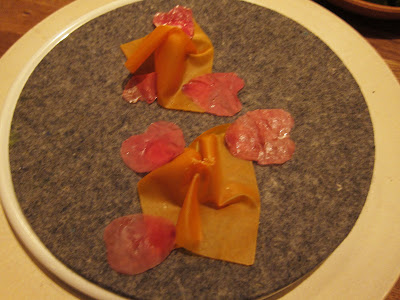
We were fortunate enough to have friends in Copenhagen who worked to get a reservation at Noma. Noma serves reinterpreted Nordic/Scandinavian cuisine and has been rated as the world's best restaurant (now that El Bulli is closing). We had very high expectations. The restaurant is located in a former warehouse in the Christianshavn neighborhood across from the tourist center of Copenhagen. We were greeted by chef Rene Redzepi who has worked at El Bulli in Spain and French Laundry in California. The first course was preceded by a series of snacks. The first was a malt flatbread in the form of a twig and juniper creme. We were instructed to pick the flatbread out of the table's centerpiece. Clearly this was not going to be your typical fine dining experience. The flatbread was followed by fried moss as you see above.

Then a cookie with lardo and currant. Ok, so it was weird and interesting, but was it going to be good?

The answer came in the form of this: rye bread, chicken skin, lump fish roe and smoked cheese. Remarkable.

Next came pickled and smoked quails egg and radish with edible soil and herbs. The eggs were gorgeous and silky and wonderful. The radish and "soil" seemed a bit gimmicky to me.


Then it was time to get Nordic. Aebleskier, a traditional Danish Christmas treat, this time with a little fish I forget the name of.

We ate 'em whole and they were great.

After the snacks, which were served with a delicious Danish white wine (yes, Danish wine) came the first course. Leek with sea weed jelly and bits of kelp reduction. Really unique.

Then razor clam and dill oil with buttermilk and horseradish powder. These were served with a 2009 'Corps de Garde' Goisot Cotes d'Auxerre.

Next was my personal favorite of the evening: thinly sliced and jerkyed scallops with beech nut, watercress, barley and squid ink. Absolutely otherworldly. Served with a 2009 Bourgogne Aligote Alice et Olivier de Moor from Chitry

A close second was the shaved chestnut and lojrom (Swedish caviar) with cress and walnut. Rich! Served with a 2008 Riesling Federspiel "Steinriegel" from Wachau.

Then things got challenging. The "Oyster and the Ocean." Oyster from north Jutland steamed with seaweed and rocks and topped with herbs picked from the beach the oysters were foraged from.

This dish was like being transported to the beach in summer time. The smell was incredible. The taste was good. The texture, a challenge. But it was beautiful.

Then a little respite. Onion and unripe grape juice with thyme and tapioca served with a 2009 Klaus Zimmerling Weissburgunder from Saxony.

You will notice an extended focus on vegetables and white wine. It was light, Nordic, and very un-French. I loved it. The most beautiful dish was the pickled vegetables and bone marrow.

The single meat focused dish of the evening was the Reindeer tongue and apple with malt and browned butter and blackened apple seeds, which was totally spectacular and served with a 2003 Barolo 'Giachina' from Piedmonte. The sole red wine served.

Then dessert started subtlely, with the pear tree. Grilled pear with raw pear on top, seasoned with juniper and verbena. The green mass was a pine infused angel food cake-like accompaniment. Served with a 2009 Riesling Spatlese 'Von Horn' from Mosel.

Finally a little walnut ice cream dust and berries with frozen cream, served with a 2009 'Le Cormier' from Coteaux du Layon. Pretty and sweet.
I have never had a meal like this in my life. Thanks to Nan Na Hvass for her beautiful pictures (my camera died halfway through plus I am beginning to think I need to take a class in indoor night food photography if this blog is going to ever look decent!) I will go back to Copenhagen and Noma, without a doubt. What a special experience.












































